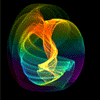Sense door tension - Discussion
Sense door tension

Dada Kind, modified 9 Years ago at 9/25/14 4:04 PM
Created 9 Years ago at 9/25/14 4:02 PM
Sense door tension
Posts: 633 Join Date: 11/15/13 Recent Posts
I found the technique DreamWalker recommends here to be very effective
After 10 days of practicing it I (seemingly) finished two cycles, both of which seemed to remove subtle tension in the visual field. My sense of sight seems more direct and less stressful.
The noself and suffering characteristics predict that there's similar tension in every sense door. So,
Here's the hearing version:
Listen to a nearby sound. Listen to a faraway sound. Now, listen to both sounds simultaneously. Notice the subtle strain in your ear and head when you try to direct your listening attention. Now, relax your attention and tune into the fact that you're already hearing effortlessly, automatically; directing your listening attention only muddles the direct, clear hearing. Tune into the subtle stress involved in maintaining the relaxed attention, apply the 3Cs. Try to direct your listening attention again, applying the 3C's to the subtle stress involved in the sense of Observing. Repeat the strain-relax several times throughout the day.
Here's the feeling version:
Direct your attention to the tip of your nose. Direct your attention to the bridge of your nose. Now, feel both your bridge of your nose and the tip of your nose simultaneously. Notice the subtle strain in your head and nose when you try to direct your feeling attention. Now, relax your attention and tune into the fact that you're already feeling your whole nose effortlessly, automatically; directing your feeling attention only muddles the direct, clear feeling. Tune into the subtle stress involved in maintaining the relaxed attention, apply the 3Cs. Try to direct your feeling attention again, applying the 3C's to the subtle stress involved in the sense of Observing. Repeat the strain-relax several times throughout the day.
If I think of a Thinking version I'll post it up. Hope someone will get some use out of this.
One last piece of advice, if you can shift your focus by looking off in the distance with a 'thousand yard stare' such that your peripheral vision is being used and you can see your nose and eges of your vision at the same time; your hands take on the quality of doing their own things and it seems like some self drops away/non-dual gets stronger. Do this a lot and get comfortable with this... it will be your new baseline without needing to use any effort to maintain.
...
1) Shift "states" so that everything is in one space, open and wide, clear, inclusive
2) Notice the difference of the "state" vs before. Notice the quietness of thought and how the selfing processes/identification seem quieter. Notice the obvious no self qualities. Notice your hands doing their own thing- driving, washing dishes and typing were very visible examples.
3) It took effort to create and stay in this "state". Look at the effort itself... explore this in every way mentioned above. Notice the subtle stress in the effort.
4) Release the effort, drop out of the "state" fast as well as slowly and notice the old basline state with its attributes come back. Notice the differences. Apply the impermanence characteristic to the differences.
5) Repeat throughout the day as much as you can every day.
...
1) Shift "states" so that everything is in one space, open and wide, clear, inclusive
2) Notice the difference of the "state" vs before. Notice the quietness of thought and how the selfing processes/identification seem quieter. Notice the obvious no self qualities. Notice your hands doing their own thing- driving, washing dishes and typing were very visible examples.
3) It took effort to create and stay in this "state". Look at the effort itself... explore this in every way mentioned above. Notice the subtle stress in the effort.
4) Release the effort, drop out of the "state" fast as well as slowly and notice the old basline state with its attributes come back. Notice the differences. Apply the impermanence characteristic to the differences.
5) Repeat throughout the day as much as you can every day.
The noself and suffering characteristics predict that there's similar tension in every sense door. So,
Here's the hearing version:
Listen to a nearby sound. Listen to a faraway sound. Now, listen to both sounds simultaneously. Notice the subtle strain in your ear and head when you try to direct your listening attention. Now, relax your attention and tune into the fact that you're already hearing effortlessly, automatically; directing your listening attention only muddles the direct, clear hearing. Tune into the subtle stress involved in maintaining the relaxed attention, apply the 3Cs. Try to direct your listening attention again, applying the 3C's to the subtle stress involved in the sense of Observing. Repeat the strain-relax several times throughout the day.
Here's the feeling version:
Direct your attention to the tip of your nose. Direct your attention to the bridge of your nose. Now, feel both your bridge of your nose and the tip of your nose simultaneously. Notice the subtle strain in your head and nose when you try to direct your feeling attention. Now, relax your attention and tune into the fact that you're already feeling your whole nose effortlessly, automatically; directing your feeling attention only muddles the direct, clear feeling. Tune into the subtle stress involved in maintaining the relaxed attention, apply the 3Cs. Try to direct your feeling attention again, applying the 3C's to the subtle stress involved in the sense of Observing. Repeat the strain-relax several times throughout the day.
If I think of a Thinking version I'll post it up. Hope someone will get some use out of this.

Teague, modified 9 Years ago at 9/25/14 9:17 PM
Created 9 Years ago at 9/25/14 9:17 PM
RE: Sense door tension
Posts: 104 Join Date: 8/1/11 Recent Posts
For thinking, I've noticed there are two (and probably more) layers of thought. There is obvious thinking which is just one notch below actually talking, and then there is subtle thinking which isn't that apparent normally. You can see the two in action if you count or say the ABCs in your head, and then think about counting or saying the ABCs in your head. The exercise could be to notice the two and the strain involved with paying attention to our thoughts... or something like that. I'll let you suss it out.
-T
-T

Psi, modified 9 Years ago at 9/25/14 11:23 PM
Created 9 Years ago at 9/25/14 11:19 PM
RE: Sense door tension
Posts: 1099 Join Date: 11/22/13 Recent Posts
I've done this experiement to find the tension created in the skull from thinking.
Sit down, close your eyes, now count silently in your mind from 1 to 100. BUT, go as fast as you can, and when you think you are counting fast, count even faster , I mean go super -turbo, then faster. When you get to 100, your head should be really tense, now gently smile, take a relaxing breath, and notice the tension pass away, it is best to consciously relax the tense cranial muscles, then you learn control. Once learned one should be able to flex and release the cranial muscles just like any other muscle. But, I am not sure how many people can access voluntary control of these cranial/scalp muscles, it is kind of like wiggling the ears...
This helps one to be aware of the "tense" mode, which one finds the mind/body seems to gravitate towards, and also to be aware of the "released" mode. When in Meditation or daily living, one can, after practice , go into the "release" mode and attain tranquility, and as a by-product, while in the release mode, dukkha has trouble arising.
Word of caution: There are muscles in the skull/cranium and if/once you activate them, maybe you already have, But the caution is NOT to over tighten or strain down too hard, I gave myself a HUGE headache one time by experimenting, pain sensation, pain sensation
By the way thanks for posting the other sense door tips, I remember the insight of the eye phenomenon, but forgot about it mostly, I always thought of it as "Kung Fu" mode....
Psi Phi
Sit down, close your eyes, now count silently in your mind from 1 to 100. BUT, go as fast as you can, and when you think you are counting fast, count even faster , I mean go super -turbo, then faster. When you get to 100, your head should be really tense, now gently smile, take a relaxing breath, and notice the tension pass away, it is best to consciously relax the tense cranial muscles, then you learn control. Once learned one should be able to flex and release the cranial muscles just like any other muscle. But, I am not sure how many people can access voluntary control of these cranial/scalp muscles, it is kind of like wiggling the ears...
This helps one to be aware of the "tense" mode, which one finds the mind/body seems to gravitate towards, and also to be aware of the "released" mode. When in Meditation or daily living, one can, after practice , go into the "release" mode and attain tranquility, and as a by-product, while in the release mode, dukkha has trouble arising.
Word of caution: There are muscles in the skull/cranium and if/once you activate them, maybe you already have, But the caution is NOT to over tighten or strain down too hard, I gave myself a HUGE headache one time by experimenting, pain sensation, pain sensation
By the way thanks for posting the other sense door tips, I remember the insight of the eye phenomenon, but forgot about it mostly, I always thought of it as "Kung Fu" mode....
Psi Phi

Dream Walker, modified 9 Years ago at 9/25/14 11:53 PM
Created 9 Years ago at 9/25/14 11:53 PM
RE: Sense door tension
Posts: 1683 Join Date: 1/18/12 Recent Posts
The thing I noticed after first path with vision that it was easy to "drop" the tendency to ALWAYS have a focal point. This inclusive panoramic quality of vision was just letting go of the habit of always choosing....and where is the chooser? This ability to let go of the focal point so effortlessly faded but came back more pronounced after second path.
I think the analog for hearing and feeling and thinking would have to start with where is the focal point that seems always prevalent within that sense door and how can you let go of it completely.....stop the chooser choosing and expand to inclusiveness.
I have been playing with space a lot on the cushion....with sound I take the nada sound/meditative tinnitus and notice the quality of internal sound vs the vent blowing in the sauna as a constant external sound. I move between the sounds' spacial qualities and try to get a good grasp of the arbitrariness of referential locations. Even though the center point is "hollow" if everything is still in relationship to it then everything is still pointing to it referentially. Trying to vipassana this stuff. This is one of the sound exercises.
Glad your having luck with the visual stuff...when it faded I really missed it...I wanted to warn others to maybe work on this so it wouldn't fade on them.
Panoramic vision is a cool superpower that gets more and more nifty as you go along....I'm really digging it more now than ever...
~D
I think the analog for hearing and feeling and thinking would have to start with where is the focal point that seems always prevalent within that sense door and how can you let go of it completely.....stop the chooser choosing and expand to inclusiveness.
I have been playing with space a lot on the cushion....with sound I take the nada sound/meditative tinnitus and notice the quality of internal sound vs the vent blowing in the sauna as a constant external sound. I move between the sounds' spacial qualities and try to get a good grasp of the arbitrariness of referential locations. Even though the center point is "hollow" if everything is still in relationship to it then everything is still pointing to it referentially. Trying to vipassana this stuff. This is one of the sound exercises.
Glad your having luck with the visual stuff...when it faded I really missed it...I wanted to warn others to maybe work on this so it wouldn't fade on them.
Panoramic vision is a cool superpower that gets more and more nifty as you go along....I'm really digging it more now than ever...
~D

Dada Kind, modified 9 Years ago at 9/26/14 2:40 PM
Created 9 Years ago at 9/26/14 2:39 PM
RE: Sense door tension
Posts: 633 Join Date: 11/15/13 Recent Posts
@Teague
Wow, so I was trying to think of a technique for thought and I tinkered with the idea of ABCs and counting. Sometimes I wonder if sanghas really have some kind of hivemind. I agree that there are more than 2 layers of thought; I'm often aware of different layers of subconscious processing. Thanks for replying
@Psi Phi
Nice. I didn't think to count rapidly, that's genius. And, the learning to use head muscles is also a great idea. I actually remember myself as a child teaching myself to wiggle my ears. I think I'm gonna try the same with as many head and neck muscles as I can. Thanks!
@Dream
I'm not sure that finding the focal point of the sense door is necessary. In directing the attention to different aspects of the sense door while paying close attention a certain sensitivity is built towards the strain involved. I believe that over time one would begin to notice when one's creating an unnecessary focal point. At least, that's my current take on it.
Race ya to 4th, Dream
Wow, so I was trying to think of a technique for thought and I tinkered with the idea of ABCs and counting. Sometimes I wonder if sanghas really have some kind of hivemind. I agree that there are more than 2 layers of thought; I'm often aware of different layers of subconscious processing. Thanks for replying
@Psi Phi
Nice. I didn't think to count rapidly, that's genius. And, the learning to use head muscles is also a great idea. I actually remember myself as a child teaching myself to wiggle my ears. I think I'm gonna try the same with as many head and neck muscles as I can. Thanks!
@Dream
I'm not sure that finding the focal point of the sense door is necessary. In directing the attention to different aspects of the sense door while paying close attention a certain sensitivity is built towards the strain involved. I believe that over time one would begin to notice when one's creating an unnecessary focal point. At least, that's my current take on it.
Race ya to 4th, Dream





